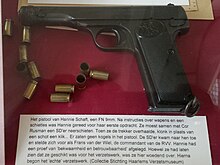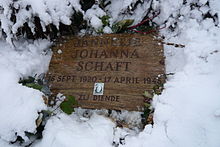Hannie Schaft
Hannie Schaft | |
|---|---|
Resistance fighter during World War II | |
| Awards | Righteous Among the Nations |
| Righteous Among the Nations |
|---|
 |
| By country |
Jannetje Johanna (Jo) Schaft (16 September 1920 – 17 April 1945) was a Dutch resistance fighter during World War II. She became known as "the girl with the red hair" (Dutch: het meisje met het rode haar, German: das Mädchen mit dem roten Haar). Her secret name in the resistance movement was "Hannie".
Early life and education
Jannetje Johanna Schaft was born in
From a young age, Schaft discussed politics and social justice with her family, which encouraged her to pursue law and become a human rights lawyer.
Resistance work

Schaft's resistance work started with small acts. First, she would steal ID cards for Jewish residents (including her friends).[1] Upon leaving university, she joined the Raad van Verzet ('Council of Resistance'), a resistance movement that had close ties to the Communist Party of the Netherlands.[2] Rather than act as a courier, Schaft wanted to work with weapons. She was responsible for sabotaging and assassinating various targets.[2] She carried out attacks on Germans, Dutch Nazis, collaborators and traitors. She learned to speak German fluently and became involved with German soldiers.
Schaft did not, however, accept every assignment. When asked to kidnap the children of a Nazi official she refused. If the plan had failed, the children would have to be killed, and Schaft felt that was too similar to the Nazis' acts of terror.[3] When seen at the location of a particular assassination, Schaft was identified as "the girl with the red hair". Her involvement led "the girl with the red hair" to be placed on the Nazis' most-wanted list.[2]
On 21 June 1944, Schaft and Jan Bonekamp, a friend in the resistance, carried out an assassination in

Upon recovery, Schaft dyed her hair black and wore glasses to hide her identity and returned to Resistance work. She once again contributed to assassinations and sabotage, as well as courier work, and the transportation of illegal weapons and the dissemination of illegal newspapers.[4] Hannie Schaft and Truus Oversteegen were planning to liquidate NSB member and Haarlem policeman Fake Krist on 25 October 1944, but other Haarlem resistance fighters were ahead of them.
On 1 March 1945, NSB police officer Willem Zirkzee was executed by Hannie Schaft and Truus Oversteegen, near the Krelagehuis on the Leidsevaart in Haarlem. On 15 March they wounded Ko Langendijk, a hairdresser from IJmuiden who worked for the Sicherheitsdienst (SD), a Nazi intelligence agency. He survived the attack and in 1948 he testified in Amsterdam for the benefit of his Velser girlfriend, the traitor Nelly Willy van der Meijden. In 1949 he was sentenced to life imprisonment.
Arrest and death

She was eventually arrested at a military checkpoint in Haarlem on 21 March 1945 while distributing the illegal communist newspaper de Waarheid ('The Truth'), which was a cover story. She was transporting secret documentation for the Resistance. She worked closely with Anna A.C. Wijnhoff.[5] She was brought to a prison in Amsterdam. After much interrogation, torture, and solitary confinement, Schaft was identified by the roots of her red hair by her former colleague Anna Wijnhoff.[5]
Schaft was executed by Dutch Nazi officials on 17 April 1945.[5] Although at the end of the war there was an agreement between the occupier and the Binnenlandse Strijdkrachten ('Dutch resistance') to stop executions, she was shot dead three weeks before the end of the war in the dunes of Overveen, near Bloemendaal.[5] Two men known as Mattheus Schmitz and Maarten Kuiper[6][7] took her to the execution site. Schmitz shot her in the head at close range. However, the bullet only grazed Schaft. She allegedly told her executioners: Ik schiet beter "I shoot better!", after which Kuiper delivered a final shot to her head. Schaft's execution was directly ordered by Willy Lages.[5][8]
Although Schaft's supposed final words became famous, they were never confirmed. A Dutch World War II historian said a search through the Dutch archives does not ever mention Schaft saying "I shoot better!" During a post-war interrogation, Kuiper said he had been talking to Schaft when he suddenly heard a gunshot after which she cried out in pain and started shaking. Realizing that Schmitz had only grazed her, Kuiper took out his submachine gun and fired a burst at Schaft, after which she immediately collapsed. One of the shots hit her in the head, killing her.[9]
On 27 November 1945, Schaft was reburied in a state funeral at the Dutch Honorary Cemetery Bloemendaal. Members of the Dutch government and royal family attended, including Queen Wilhelmina, who called Schaft "the symbol of the Resistance".[5]
Legacy


It is not known if Schmitz was ever prosecuted. However, Kuiper and Lages were prosecuted for war crimes by Dutch courts. Kuiper was found guilty, sentenced to death, and executed in 1948.
After the war, the remains of 422 members of the resistance were found in the Bloemendaal dunes, 421 men and one woman, Hannie Schaft. She was reburied in section 22 at the honorary cemetery
Because the Dutch communist party celebrated her as an icon, her popularity decreased, to the point that the commemoration at Hannie's grave was forbidden in 1951.[5] The commemorators (who were estimated to number over 10,000) were stopped by several hundred police and military with the aid of four tanks. A group of seven managed to circumvent the blockade and reached the burial ground, but were arrested when they tolled the bell. From the next year on, the communists decided to prevent another such scene by holding their commemoration in Haarlem instead.
A number of schools and streets were named after her. For her, and other resistance heroines, a foundation has been created: the National Hannie Schaft Foundation (Dutch: Nationale Hannie Schaft Stichting).[15][16] A number of books and movies have been made about her. She features in The Assault (De Aanslag, 1982) by Harry Mulisch, also released as a movie directed by Fons Rademakers. Ineke Verdoner wrote a song about her. Author Theun de Vries wrote a biography of her life, which has inspired the movie The Girl with the Red Hair (Het Meisje met het Rode Haar, 1981) by Ben Verbong featuring Renée Soutendijk as Hannie Schaft. Her life is the basis of the 2023 historical novel, To Die Beautiful by Buzzy Jackson. She is remembered each year in November during a national event held in Haarlem.[17]
In the early 1990s, thanks to the Hannie Schaft Memorial Foundation, commemorations were once again permitted. The last Sunday of each November in the Netherlands is a day of remembrance for Schaft's life and work.[18]
See also
References
- ^ ISBN 9781556529610.
- ^ ISBN 9781556529610.
- ISBN 9781556529610.
- ^ ISBN 9781556529610.
- ^ ISBN 9781556529610.
- ^ dirkdeklein (26 February 2016). "Forgotten History-Hannie Schaft resistance fighter". History of Sorts. Retrieved 5 September 2022.
- ^ Hopmans, Rob. "Schaft, Jannetje Johanna "Hannie"". WW2 Gravestone. Retrieved 5 September 2022.
- ^ "Schaft, Hannie - TracesOfWar.com". www.tracesofwar.com. Retrieved 20 September 2022.
- ^ a b "De vele mythes rond Hannie Schaft – Mei tot Mei". meitotmei.nl. Retrieved 20 September 2022.
- ISBN 978-1-925736-37-3.
- ^ "Death Sentence of Nazi Who Deported Dutch Jews Commuted". Jewish Telegraphic Agency. 20 March 2015. Retrieved 20 September 2022.
- ^ "Death Sentence of Nazi Who Deported Dutch Jews Commuted". Jewish Telegraphic Agency. 20 March 2015. Retrieved 20 September 2022.
- ^ Limited, Alamy. "Demonstration of the Auschwitz Committee in Amsterdam with the aim of placing Willy Lages of war criminal within the reach of Nedelandse Justice Description: Protesters at the Muntplein Date: 18 September 1966 Location: Amsterdam, Noord-Holland Keywords: demonstrations, banners Personal name: Lages, Willy Stock Photo - Alamy". www.alamy.com. Retrieved 20 September 2022.
- ^ Erik Müller, Schaft, Jannetje Johanna at onderscheidingen.nl
- ^ "Nationale Hannie Schaft Stichting" (in Dutch). Retrieved 28 May 2020.
- ^ Roberts, Sam (25 September 2018). "Freddie Oversteegen, Gritty Dutch Resistance Fighter, Dies at 92". The New York Times.
- ^ "Herdenkingen". Eerebegraafplaatsbloemendaal.eu. Retrieved 7 April 2014.
- ISBN 9781556529610.
